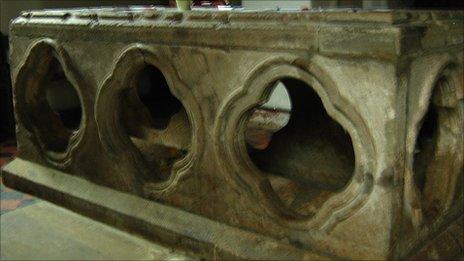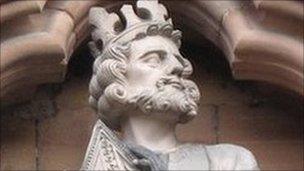Anglo-Saxon Mercia: some facts and some legends
- Published

Many pilgrims still come to pray at the grave of St Bertram in Ilam - but did he really exist?
During the Dark Ages, the lands we now call Staffordshire were then the centre of the kingdom of Mercia.
But now, because of the discovery of the Staffordshire Hoard treasure-trove, which dates to that time, there's a new enthusiasm for learning about Mercia.
Some stories of Mercia are legends - but some unlikely ones are true.
Hear of: the prince martyrs from Stone; Penkridge's great day; the currency king; the woman general; the battle-site at Alton Towers - and more.
See photo-gallery: Looking for evidence of Saxons in Staffordshire
During this era, few written records were kept, so many stories arose - some of which may be uncheckable...
---
The story of Stone
The most famous Staffordshire legend of Anglo-Saxon times is that the foundation of the mid-Staffordshire town of Stone.
It is told that the great Mercian king, Wulfhere, who had a palace at nearby Tittensor, was horrified when his two sons, Wulfad and Ruffin (also Rufin), converted to Christianity.
The legend says the two boys followed a white stag into the forest - where they met St Chad, who persuaded them to become Christians.
But when he found out, the angry Wulfhere killed his sons; and on that same spot their sorrowing mother buried them under a cairn of stones. A church was built over these stones in 670, just one of the buildings that was predecessor to the present church of St Michael & St Wulfad.
And that is how the town around it, 'Stone', got its name.
Is it all true? Well, Wulfhere did have problems with Christianity, being the last Mercian king to be a pagan, though he did later endow a number of religious houses and was father to the holy St Werburgh.
However - there's no record at all of Wulfad and Ruffin, even though both have churches in the county dedicated to them.
So, is it true? Sadly… it is all very doubtful. But don't tell the people of Stone.
----

King Offa's 'penny' was the standard coinage for 500 years
Currency expert
Hard to believe but… the story goes that, even though England was already united in the 10th Century and being firmly administered by the Normans from the 11th, the currency used by ordinary folk over this whole period (and until the 1300s) was that first minted by King Offa of Mercia in the 800s.
This story is true.
Offa's "penny" circulated through the country for 500 years as the one trustworthy coin.
Examples of this Anglo-Saxon coinage can be seen at Tamworth Castle's museum and in the British Museum.
---
Penkridge - ancient capital?
The people of Penkridge just south of Stafford will happily tell you that their town was once the capital of England. Sometimes they tell you it was capital for a day… or three days… or three years. They are never quite sure.
The fact is that King Edgar did visit the town and did issue a proclamation from there, a sign of some prestige for the town, but as it happened before he formally became king, it is hard to work out how the town could claim to be called a capital.
So, is it true? Sadly, no. The town's historians are now examining that part of the history anew.
---
Iron lady
Each era produces its great women - the Britons and Boadicea, the Tudor age and Elizabeth I. For the Anglo-Saxons, it was Ethelfleda (Ethelflaeda) the "Lady of The Mercians", the daughter of Alfred The Great and the scourge of the Vikings.
Ethelfleda ruled Mercia after the death of her husband; and pushed the Vikings, who had already destroyed Tamworth once, as far back as York. Under her the Mercians helped defeat Viking power in central England - and who knows what might have happened if Ethelfleda had lived? But she died in 918 - and the Vikings returned to destroy Tamworth yet again in the 940s.
This is a true story. Her statue stands outside Tamworth Castle.
It's also said that Ethelfleda may have come up with the idea of the three-looped Stafford Knot, the symbol of Staffordshire. A story goes that she looped her girdle around two of her local allies to signify their bondship.
---
Stafford's patron saint
St Bertelin, external (also known as Bertram) has the most colourful legend of all.
Supposedly a member of the Mercian royal family, he returned from a visit to Ireland with a princess he loved.
She went into labour as they journeyed through a forest, so he set out to look for food. When he returned, she and the baby were dead, having been attacked by wolves.
His grief made him vow to become a hermit, and he set up on a site that is now in Stafford at St Mary's Church. Later he moved to an even more remote spot, at Ilam in the Staffordshire Moorlands, where his shrine is today, and where people still come on pilgrimage to pray at his tomb.
Did he exist? No one really knows. There is no definite evidence - but if he did not, why does his name have such a strong hold across this area?
He is even the patron saint of Stafford.
---
The battle of... Alton Towers
Underneath the rides at Alton Towers is a little spot, known on Ordnance Survey maps as "Slain Hollow". The story goes that King Ceolred of Mercia built a fort on Bunbury Hill (on which Alton Towers is today), only to be besieged there in 716 by King Ina of Wessex.
In the battle that resulted, which was a "draw", so many warriors died that locals dubbed it Slain Hollow thereafter.
Is the story true? Well, the battle is mentioned in a one of the chronicles, although the result is sometimes claimed as a victory for Ceolred. And the name 'Slain Hollow' - is that named after the battle? Who knows?
Other Saxon battles are thought to have happened in Staffordshire. At Checkley (near Uttoxeter) they speak of the battle of Deadman's Green, where the warriors fought naked. Near Burton, there is a footpath known as the Battlestead Walk. At Tutbury, they talk of the "massacre of the Danes" on Hound Hill in 1002. And one of the invasions by the Danes wiped out Tamworth.
One of the greatest battles of the Saxon era occurred near present-day Tettenhall, near Wolverhampton. In 910, Ethelfleda (Ethelflaeda) and her Mercian army joined with her brother Edward's army of Wessex men and marched on an invading Viking army. In the massive slaughter that ensued, two Viking kings died. The defeat was so great, it may have been the turning point for what came to be known as England. The Danes/Vikings would never be the same threat again.
Of course, there is always a mystery. Where did the Battle of Tettenhall (or Wodnesfeld) actually take place? It's possible the battle was nearer to present-day Wednesfield than to Tettenhall, but theories are still being explored. And what is the significance of 'Warrior's Tomb', a construction of boulders at nearby Bushbury?
- Published7 April 2011
- Published4 April 2011